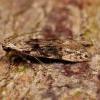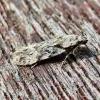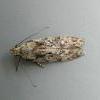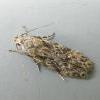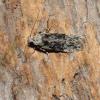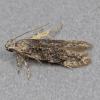35.148 Carpatolechia fugitivella (Zeller, 1839)
Status and Distribution
Local to locally common in England, Wales, local in southern and central Scotland and the Channel Islands. Very local in northern and north-east Scotland, Ireland and Isle of Man.
Provisional map
Foodplant and Larval Feeding Signs
Ulmus spp. including Ulmus glabra (wych elm), see distribution map. Only known with certainty on elm in the British Isles and it is stated that this is probably true for most of Northern Europe. In 2014 bred from Prunus spinosa in Yorkshire.
There is a report of it being bred from an unspecified Malus spp. in Gloucestershire in 1931, which requires confirmation, and an adult was found resting on a Lime trunk in 1960 in Hyde Park, London.
In Europe found on a wide range of other deciduous trees including Quercus (oaks), Corylus (hazel), Prunus avium (wild cherry), Pyracantha coccinea (firethorn), Acer (maples), Tilia (lime) and Fraxinus (ash).
In spun leaves and shoots.
Habitat
Woods, parks, gardens and hedgerows.
Finding the Moth
Larva: spins together leaves and shoots.
Adult: has been found resting in crevices on tree trunks and readily comes to light.
Similar Species
Quite a variable moth with darker and lighter specimens occuring.
In the usual form the moth has a darker area of scales on the forewing between one-quarter and two-thirds to three-quarters. In more uniformly darkish grey specimens it can resemble C. notatella but this species flies slightly earlier in the year (May and June) and lacks the slightly raised scales present in fresher C. fugitivella.
Paler specimens can superficially resemble a smallish C. proximella but usually have a black sinuate streak in the centre of the forewing in the basal half. In paler specimens in particular, a black spot, sometimes slightly extended, occurs at the base of the costa of the forewing. C. decorella has a more prominent and longer black bar in that position which is only difficult to see in the darkest forms of that species. If any doubt exists then dissection is recommended.
Single brooded, from early June to early September.
Earliest: 16th May 1997 (VC113). There is also an exceptionally early record from VC35 (21st April 1981)
Latest: 8th October 1986 (VC16). Only a very small number of records after early September and this is the only October record on the database.

